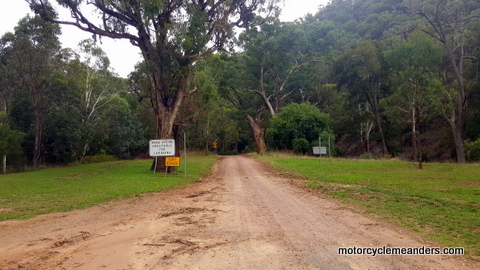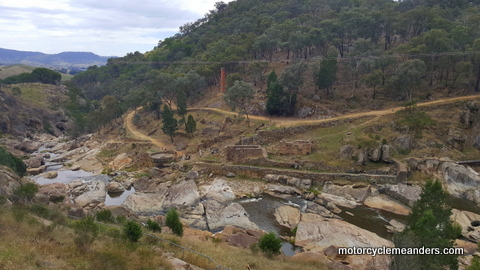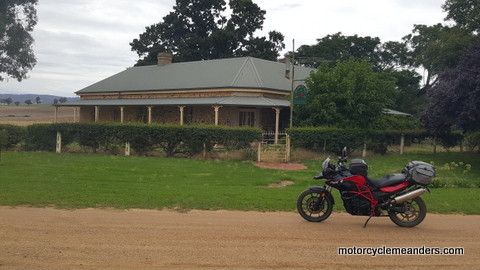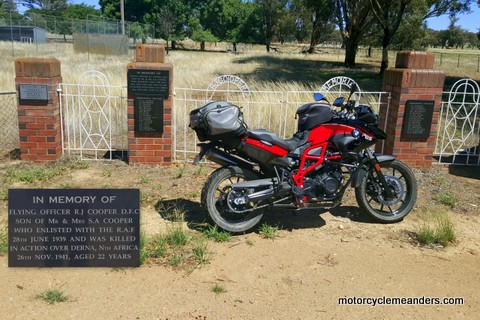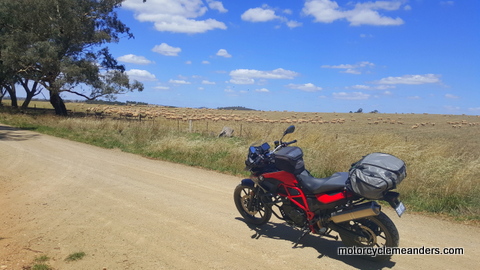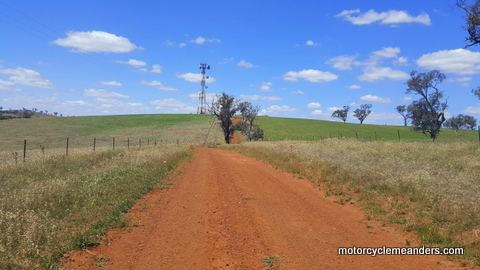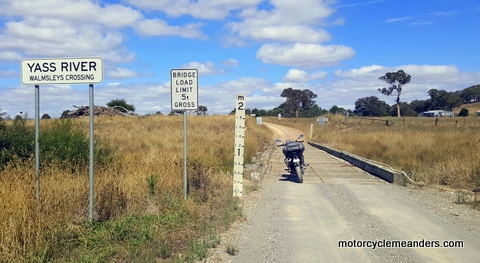
 |
|
Back Roads in the Riverina Canberra-Wagga Wagga February 2106 While it's possible to have a straightforward highway run between the cities of Canberra and Wagga Wagga, there are lots of options that can mostly avoid the Hume Highway. On one particular ride, I decided to try some back roads, including some gravel. Getting Over the Brindabellas
I’d been on the Wee Jasper road only once before. An unhappy experience. Coming from Tumut on that occasion – preceded by some local showers – I discovered that the mostly good gravel road sharply deteriorates over the last 10km into Wee Jasper into a rough, narrow, muddy, steep and slippery forest track. It didn’t quite work with standard road tyres. That cost me my Honda Crossrunner. With the recent memory of coming to grief on the road, I approached it this time with some trepidation. It’s a good quality bitumen (and a good motorcycling) road from Canberra to Wee Jasper. The gravel starts at Wee Jasper. And does so with a vengeance. Mercifully it was dry this day; and more manageable to climb in the dry than descend in the wet! It’s still a narrow and rough road that climbs steeply and turns tightly over those fateful 10km before opening into a wider and better graded gravel road to Tumut. Gems from the Past
There’s not much to Tumblong, although history suggests it once had its day in the sun. The old road between Sydney and Melbourne used to go through it but no longer. The plan was to cross the Hume Highway at Tumblong and proceed on a dirt road marked on the GPS as the “Old Hume Highway”, cross the Murrumbidgee River at Mundarlo and come into Wagga Wagga through Wantabadgery. However, I missed a vital turn-off across the Murrumbidgee and ended up on a lesser dirt road that had my Zumo 590 GPS totally confused and frustrated (and becoming gratuitously abusive). Once I persuaded the Zumo to ‘get over it’ and just take me to the RAAF Base (a necessary port of call to collect keys), it finally desisted from wanting me to make a U-turn and agreed that I could continue straight ahead.
I subsequently found out that the Junction Hotel was built by John Griffiths, a free settler. It was a Cobb & Co staging inn but closed in 1906. It's been modernised into a 4-bedroom cottage to accommodate staff working on Deltroit Station of which it is now part. Deltroit station is a 2,545-hectare property, with a 1903 Federation brick homestead. It last changed ownership in 2013 for $15.5 million. I was a bit miffed that the Old Hume Highway was a dirt road – and such a long way from the current highway. Invariably, roads designated “Old Hume Highway” are discarded bitumen sections replaced by the new dual carriageway. I later discovered that the original highway in this area went well to the west of Tumblong via Mundarlo. This is illustrated in the accompanying diagram by the yellow road called “The Old Hume Highway Road.” It’s now listed as an “historic route” as opposed to the more conventional sections called “Old Hume Highway”. Some current maps still describe the east/west section as the “Old Hume Highway”; but call the north/south section “Mundarlo Road.” Others refer to the whole loop as “Mundarlo Road.” In 1938-40, with the building the Hillas Creek concrete bridge in 1938 and the excavation of a large cutting at Sylvia’s Gap, the Hume Highway was relocated to a shorter route through Tumblong, saving 14km. In 1983, the current dual carriageway deviation was built that by-passed the settlement of Tumblong. Having indulged my historical fascination with the Junction Hotel, I found the road continuing onto the Sturt Highway and into Wagga Wagga still had some surprises with a thickly wooded ridge to enjoy before reaching the bitumen. While my original plan had avoided the Sturt Highway until I was well into Wagga Wagga, the additional highway riding was a small price to pay for the discovery of the Junction Hotel; and learning some previously unknown history about the (very) Old Hume Highway. A Longer Way Back
First notable sight was a small memorial at Eurongilly not far from Wagga Wagga. There’s no town there. It’s just a ‘location’ but with a bush fire brigade shed; and a war memorial which seems to have started life as a tribute to a local 22-year-old, R J Cooper, who, as a 20-year-old, had joined the RAF and, according to the plaque, was shot down over Derna in North Africa on 26 November 1941. It was a grim reminder of sacrifices made; and some initial searches didn’t reveal any more than what was on the plaque.
The dreamtime ride was interrupted as the dirt lanes delivered me to Binalong on the Burley Griffin Way and thence onto the Hume Highway for the short run to Yass. From Yass there’s another pleasant, mostly dirt road that follows the small Yass River as it winds through the Yass Valley to Gundaroo and beyond. The road crosses the river a few times and moves away from it to cross a couple of wooded ridges.
And to think I was only 2.7km from the end of the Yass River Road: the intersection where it meets the bitumen Gundaroo Road. The good news was that the tow truck could at least take me to the Gundaroo Colonial Inn (aka Crowe’s Restaurant/ Gundaroo Smoke House) where I decided to call an end to the day and enjoy a hearty meal with a glass or two of red! |
